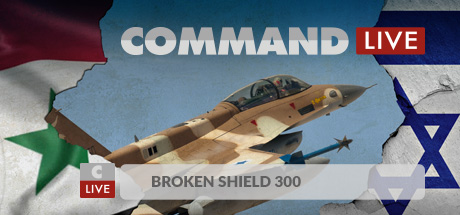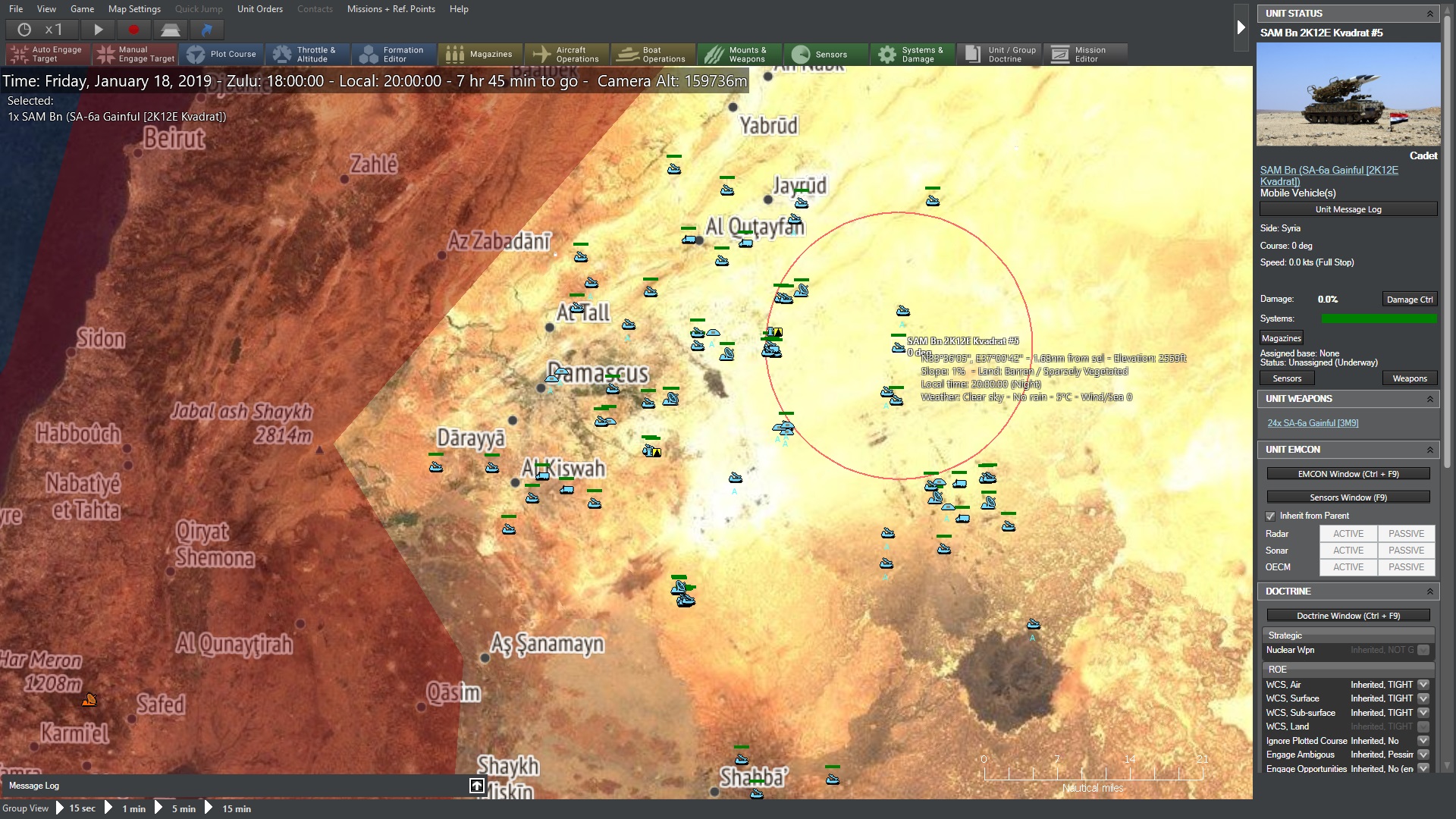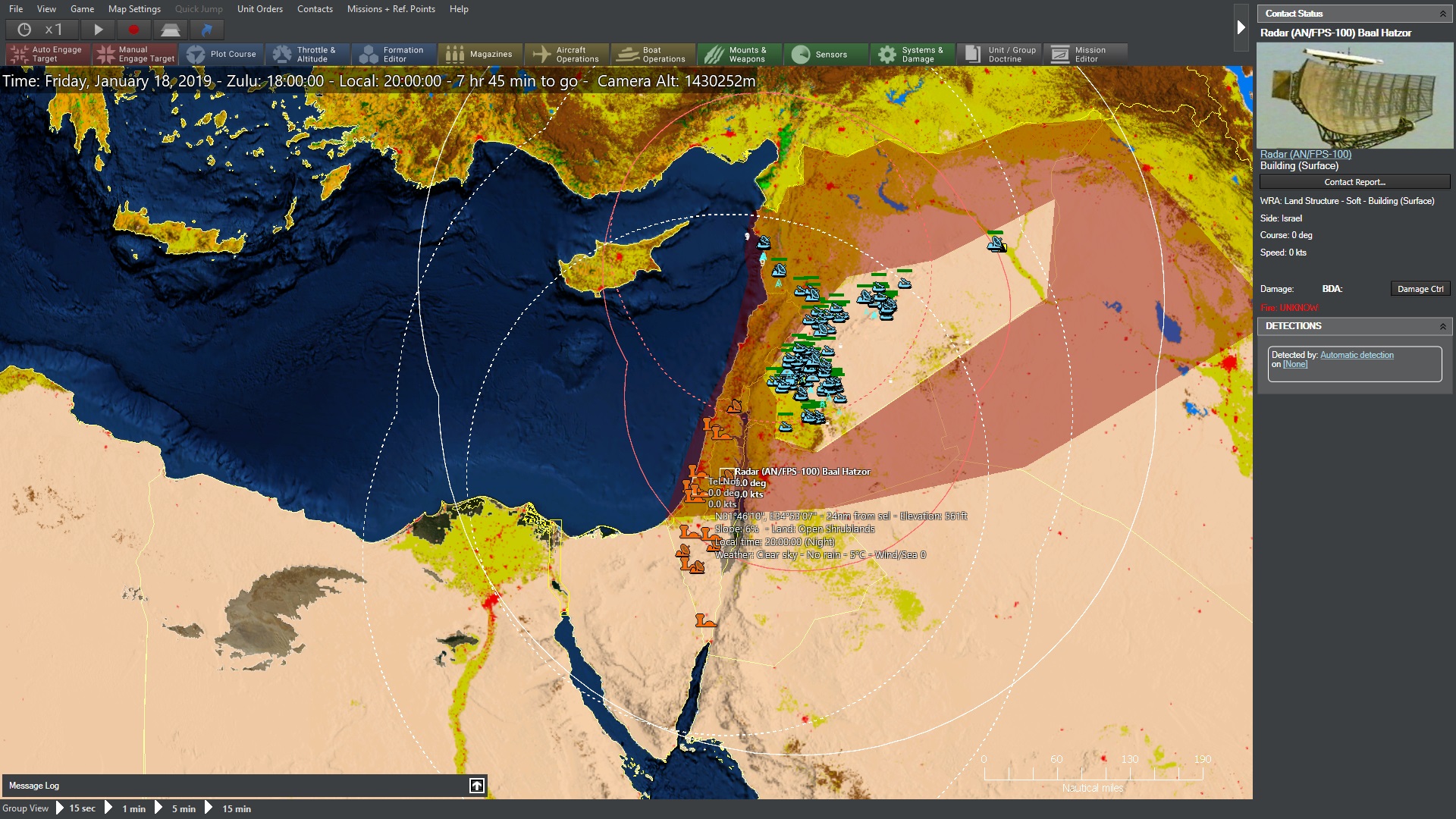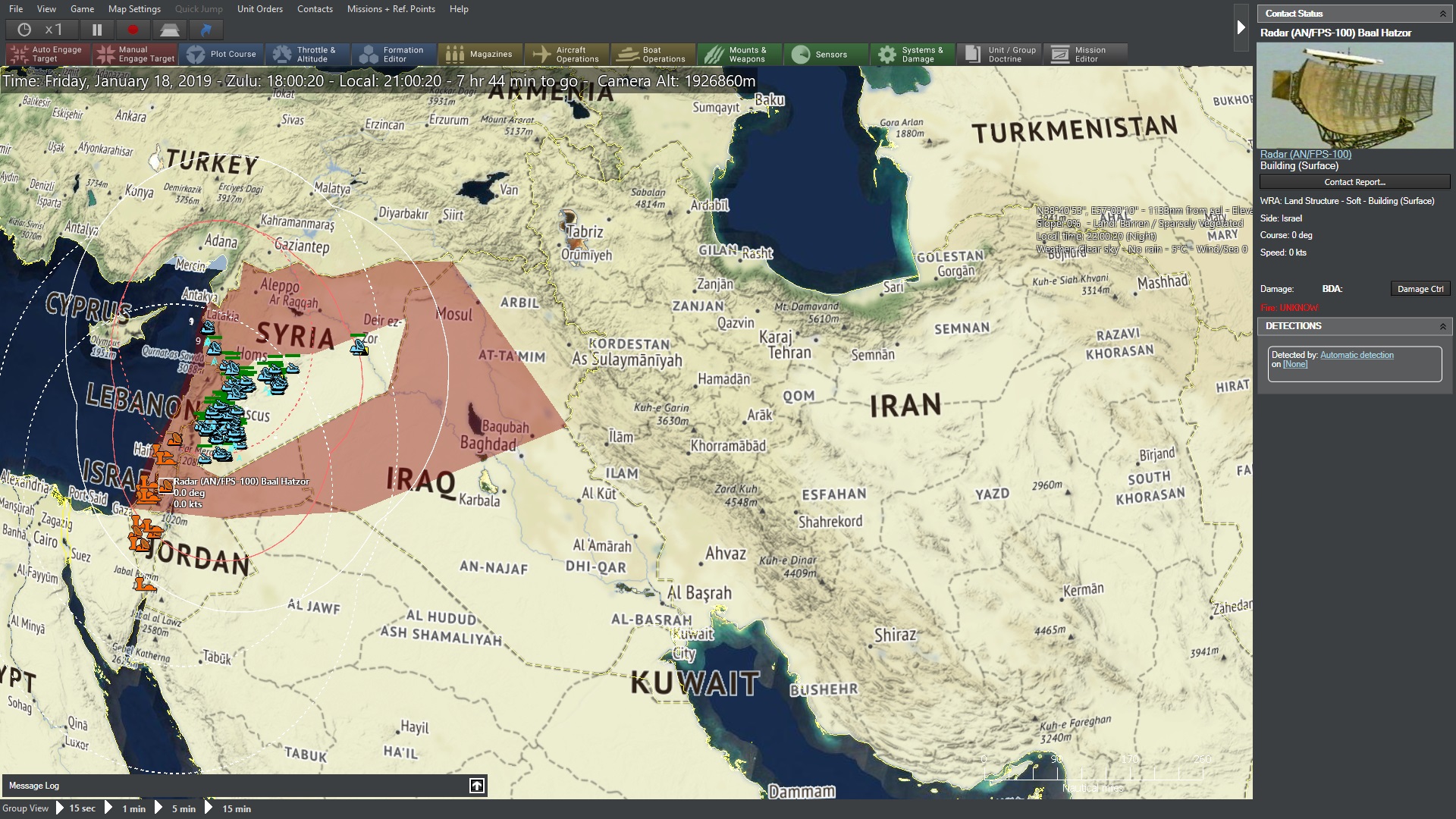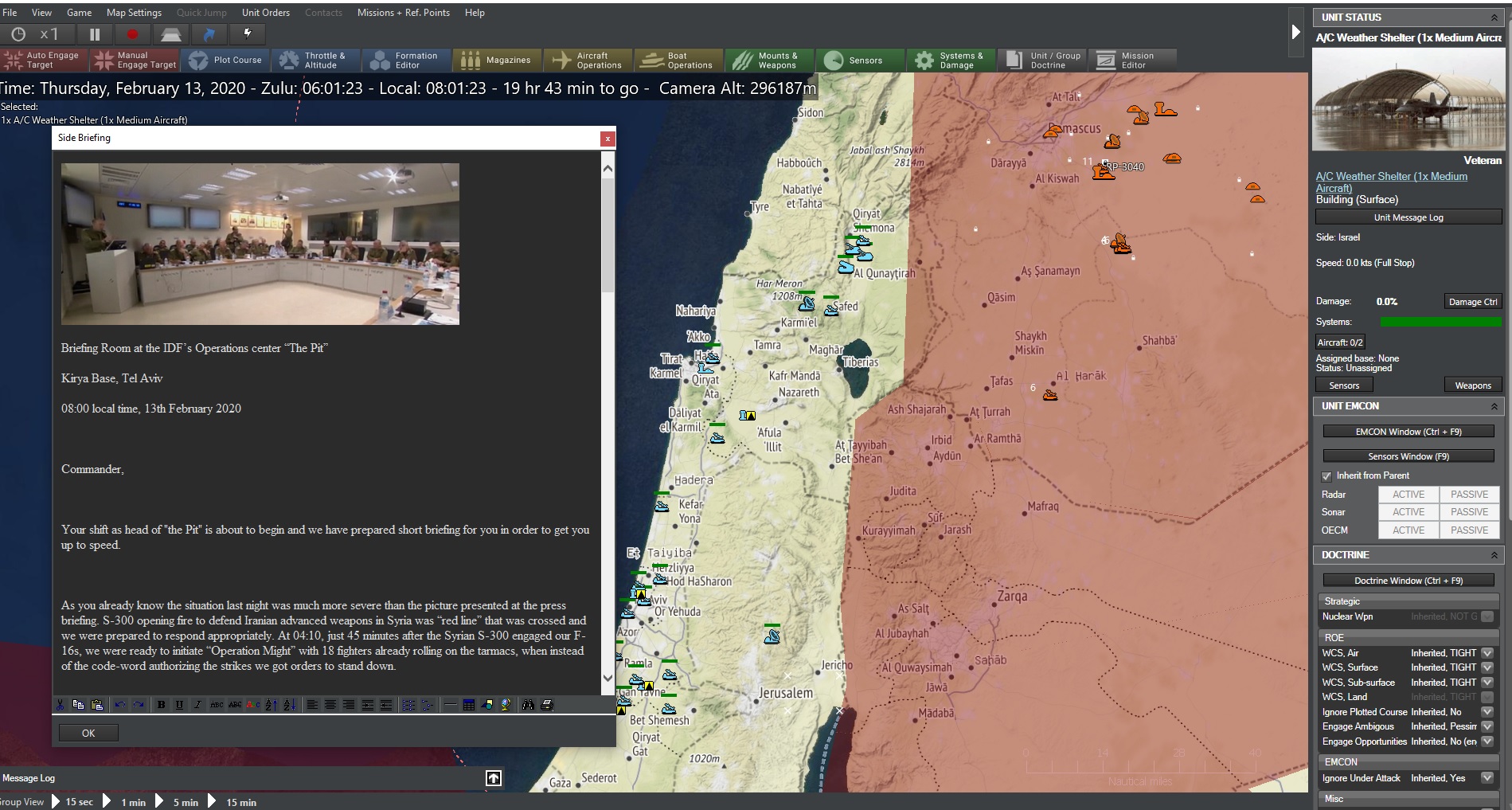FROM CMANO TO CMO FAQ - READ HERE
IMPORTANT. This DLC is not backwards compatible with CMANO
Command LIVE is a very ambitious project. Its aim is to recreate highly accurate scenarios from real-world situations and events, as they happen. WarfareSims has teamed up with the best editors and modders from the community, to create short, engaging scenarios that re-create real life events. Where geopolitical instability calls for military power to come into play, the Command LIVE project calls for players.
Inspired by the most recent geopolitical events, Command: MO LIVE – Broken Shield 300 scenario depicts how the Heyl Ha'Avir (or IAF, Israeli Air Force) would act in case of a military escalation in Syria and its final activation of S-300 missiles batteries to protect Iranian assets.
FEATURES
- Playable as Israel (main side) and Syria (limited experience)
- Carefully researched scenario featuring authentic representation of the Israeli Air Force down to the individual tail numbers in the respective squadrons
- Feasible Russian made IADS network composed of both modern [S-300 PMU-2 (SA-20B), Buk (SA-17), Pantsir (SA-22)] and legacy [S-75 (SA-2), S-125 (SA-3), S-200 (SA-5), Kvadrat (SA-6), Osa (SA-8)] air defense systems
- Realistic "what if" scenario aimed at exploring the ways to crack up to date IADS networks using all the tools available to a modern day western commander like long range stand-off weapons, OECM platforms, space based assets and even cyber attacks
- Challenging scoring system based on the necessity of maintaining very low to non casualties and extracting downed pilots from enemy territory via SAR operations before they are captured by the enemy for propaganda purposes - rich backstory along with a developing one through the scenario
BACKGROUND
After the downing of the Russian Il-20 on the 17th of September 2018, southwest of Latakia in Syria, the Russian government reacted immediately in an attempt to strengthen its ally’s air defenses. Soon, pictures of a S-300 battery arriving in Syria emerged. It was later officially stated that the battery had four TELs and consisted of 49 vehicles in total. In the late months of 2018, several reports in Russian media revealed that the delivered air defense system was being downgraded to a S-300PMU-2 while the training of Syrian personnel was taking place. Meanwhile there were other, unconfirmed, reports based on information from a “unnamed, but high ranking and reliable source within the Russian military”, stating that only three batteries had been sent to Syria. In early 2019 the Syrians supposedly completed their training program and the officially delivered S-300 battery became operational, deployed just northeast of Masyaf, right next to the position of a Russian S-400.
Following the delivery of the air defense system, many were expecting immediate escalation and military action by Israel, but the contrary actually happened - IAF sharply reduced its air activity over Lebanon and started avoiding Syrian airspace. A number of meetings between the Prime Minister of Israel and the President of Russia took place and it was widely believed that a sort of secret agreement was achieved. On April 13, 2019 the IAF took out a missile development center in a village near Masyaf, mere kilometers away from the S-300 position that remained silent during the attack. In the next months the situation went back to “normal” for the region with Israel performing surgical strikes against shipments of advanced weapons and IRGC infrastructure.
The situation escalated again on November 19, 2019 when IRGC related elements launched 4 missiles against Israel which resulted in a massive retaliation from the IAF targeting air defense systems, surface-to-air missiles, reconnaissance sites and warehouses, even the National Defense Building at the Damascus International Airport which houses the Quds Force headquarters and other military positions. Tensions remained very high as Israel was expecting retaliatory attack from Iran or Syria but were ultimately defused with Russian involvement.
For a while it seemed that the crisis was averted, and a somewhat uneasy balance of powers ensued, with Iranian proxy forces mostly engaged in the fighting in Idlib. However, by the end of 2019 the situation in neighboring Iraq was deteriorating rapidly as the tensions between US and Iran, who was attacking US forces in Iraq using its proxies, were rising very fast.
On the 3rd of January 2020 came the news that could have sparked a new big war in the Middle East - Iranian General, the leader of the Quds Force and people's icon, Qasem Soleimani was killed by US Armed forces near Baghdad International Airport. Immediately, official Tehran swore to take "harsh revenge" against US for that as they called it "act of State terrorism". But as the world trembled in fear awaiting war to erupt any second, there was division between Iran's leaders - the hardliners advocated for an all out attack against US forces in the region and Israel, while others argued that such attacks would trigger a real war and that a measured response is more appropriate.
The tug of war between both parties continued in the following days accompanied by a tragedy as dozens of people were crushed by the crowds attending General Qasem Soleimani's funeral. Fortunately, in the end cool heads prevailed and Iran geared up for a mere "show of force" attack on the Ayn al-Asad and Erbil airbases in Iraq, where US personnel was stationed. The attack itself took place in the early hours on 8th of January 2020 with media reporting "tens of ground-to-ground missiles" fired against both targets. Millions of people and news agencies around the world waited anxiously for the US response or for the first lights of the sun to pierce the darkness and to reveal the true extent of the damage done by the Iranian missiles.
But the morning came with the sad news of another tragedy - the crash of Ukraine International Airlines Flight 752 near Tehran's Imam Khomeini International Airport. First reports and videos showed the plane going down under controversial circumstances which coupled with the initial lack of an official response to the Iranian attacks from the US Government, fueled panic among some analysts who immediately signaled that war between the US and Iran is imminent, or even that it may have already begun. However later in the day US President addressed the nation, reassured the American public and the world that no casualties were suffered during the Iranian attack, that there was no major damage done to materiel and that the US Government will impose new sanctions upon Iran. The war between the two states, that so many were so firmly predicting, was not going to be, at least for the moment. The world took a deep breath of relief as it seemed another major crisis was averted.
On the 11th of January 2020 another unexpected event happened - in a briefing for the press, the IRGC Aerospace Commander openly admitted that Flight 752 was indeed accidently shot down by IRGC air defense unit. The high ranking officers of the IRGC, the Quds Force and many Government officials were anything but pleased with such a development. They not only strongly felt that a "show of force" attack wasn't enough to avenge General Soleimani's death, but they were further infuriated by the decision to admit the shootdown of Flight 752 and the involvement of the IRGC in it. The Iranian hardliners were simply not ready to accept such undermining of Iran’s influence in the region and the politic consequences in Iran itself, with protests against the regime erupting after the confession. Combined with the ever degrading economic situation and further international isolation following the shootdown, the situation was getting dire enough for them to take action. They felt that the only way to distract the public and also to "truly avenge" the death of their beloved General and national hero was to conduct a major attack against the foreign enemies of the Iranian regime. However even the hardliners were painfully aware that, for the moment, an open attack on US forces stationed in the region would be suicidal, so they had only one viable option left to pick from as their target - Israel, Iran's other sworn enemy.
Knowing of the close relations between the US and Israel, the hardliners feared an attack on the latter by Iranian armed forces might lead to a combined military response by both states, especially in the current strained relations with the US. So, the only way to conduct such an attack without direct repercussions to Iran itself would be by using the proxy forces located in Syria, Iraq and Lebanon. These forces however needed some time for proper preparation if the attacks were to be effective. Certain assets and weapons, not yet present there would have to be positioned.
The usual small shipments were getting larger and way more frequent through January 2019, suggesting that Iran was up to something. The USAF and IAF were destroying some of them in Iraq and Syria respectively, but it was clear that dangerous amount were getting through under the radar. The situation in the region made international headlines again on 6. February 2020 when multiple explosions shook the Damascus suburbs. As it later turned out the IAF destroyed big shipment of advanced guidance systems that were supposed to upgrade many of the Hezbollah’s missiles into very accurate weapons. The shipment however was inside a Syrian military base at the time of the strike, which resulted in significant amount of Syrian casualties due to massive secondary explosions of the base armories. Following the latest fiasco in Idlib and the unsatisfactory development of the talks with the opposition and the Kurds, Damascus wanted to show some strength and reacted very violently to the latest raid. In a prepared statement it was revealed that the delivery of three S-300PMU-2 batteries, among other SAMs and radars, really took place during 2019, that the training of their personnel was concluded and that they will now deploy all those new systems around Damascus and T4, where they will form an impenetrable shield to protect the Syrian sovereignty. It was further stated that any new attempts made by Israel to attack targets within Syrian territory will be met by both the Syrian Air Force and the Syrian Air Defense Force, and that from now on they will fire not only at the Israeli guided weapons, but also at the aircrafts carrying them - even if they are outside Syrian airspace.
Russia was not happy with such significant development of the situation, but there wasn’t much they could do to prevent an accident that could spark a chain reaction, so they initiated diplomatic efforts trying to persuade Israel to abandon its policy of attacking targets within Syrian territory with the promise of executing real pressure on Iran, forcing it to stop deliveries of weapons to Hezbollah in Lebanon through Syria. Meanwhile, assuming that Russia has no other choice, but to take their side for the good of Syria, should something go wrong, Iran decided to urgently airlift new shipment of advanced guidance systems for Hezbollah’s missiles as replacement for the destroyed one in order to stay on schedule for the planned missile attack against Israel, that was to be performed from Lebanon. In the late hours of 12th February 2020 an Iranian cargo Boeing 747 took off from Bandar Abbas heading for Damascus.
After a heated debate, the Israeli Cabinet decided that such shipment simply can’t be let intact - even if such actions risk a serious escalation in the light of the recent Syrian threats. A few hours later the Prime Minister authorized an air attack to neutralize the threat and before the first sunlights appeared in the sky on the 13th February 2020, the Iranian Boeing 747 itself and the cargo it was transporting were no more than smoldering remains scattered on one of Damascus International Airport’s tarmacs.
Since the numerous explosions and the work of the newly deployed air defense systems were heard and seen by many, Syrian officials could not hide or downplay the incident. They decided to again react violently, accusing Israel of aggression and uncalled destruction of an unarmed aircraft, carrying "humanitarian supplies". As usual, the Syrian military representatives declared yet another consecutive victory over the IAF, with numerous planes and missiles shot down by the air defenses.
Usually such statements were always left without comment from the Israeli side, but this time just 2 hours after the incident, press briefing was announced for 07:00 local time. Such an extraordinary event quickly attracted enough attention and rumors began to spread that the IAF might have indeed lost some planes and that the situation might be very serious. At exactly 07:00 the Israeli Prime Minister himself stood in front of the journalists giving an extended briefing in which he exposed the true cargo of the destroyed aircraft and also told the media that this time the S-300 actually opened fire at the IAF aircraft that were inside Israeli airspace at the time. Thanks to their towed decoys, two F-16’s were only damaged but nearly a dozen missiles had been fired. He further stated, that the Israeli Cabinet had unanimously agreed, that the Syrian military has “crossed the red line” by engaging aircrafts inside Israeli airspace in order to protect Iranian weapons shipment. It was also revealed that the President of Russia will be hosting an urgent meeting in Kremlin later that day in order to try and disarm the current “very serious” situation. The statements that Israel is not looking for an open conflict with Syria were followed by a promise that the IDF will not take any provocative actions before or during the talks in Moscow in order to give chance for any possible diplomatic solutions to the current crisis.
In a matter of minutes after the press briefing in Tel Aviv, Syria and Israel were all over the world’s headlines. And while military experts and armchair generals were speculating on the IAF’s chances to repeat its outstanding victory in Beqaa Valley considering the involvement of "triple digit SAMs" this time, the rest of world was now looking forward to the talks in Moscow where for the first time ever Prime Minister Netanyahu will be sitting on one table together with President Putin, President Assad and possibly even President Rouhani. Yet again, in a matter of weeks, the stakes were much higher than usual with possible armed conflict just around the corner…
- Playable as Israel (main side) and Syria (limited experience)
- Carefully researched scenario featuring authentic representation of the Israeli Air Force down to the individual tail numbers in the respective squadrons
- Feasible Russian made IADS network composed of both modern [S-300 PMU-2 (SA-20B), Buk (SA-17), Pantsir (SA-22)] and legacy [S-75 (SA-2), S-125 (SA-3), S-200 (SA-5), Kvadrat (SA-6), Osa (SA-8)] air defense systems
- Realistic "what if" scenario aimed at exploring the ways to crack up to date IADS networks using all the tools available to a modern day western commander like long range stand-off weapons, OECM platforms, space based assets and even cyber attacks
- Challenging scoring system based on the necessity of maintaining very low to non casualties and extracting downed pilots from enemy territory via SAR operations before they are captured by the enemy for propaganda purposes - rich backstory along with a developing one through the scenario
Base Games (one is required)
Command: Modern Operations
OS
Windows 7 / 8 / 10
CPU
Minimum dual-core, recommended quad-core
Video/Graphics
DirectX 9.0c compatible video card with 128MB+ VRAM
RAM
Minimum 4GB, recommended 8GB
Disk
250MB



